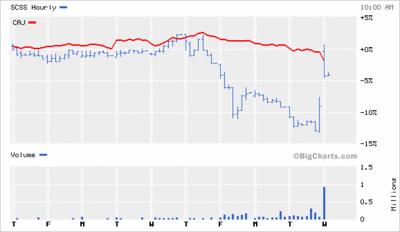Alberto-Culver shareholders are being asked to vote on a spin-off of
the company's salon products distribution business (Sally Beauty) in
November. Current owners will receive one share of New Alberto, one
share of 52.5% of New Sally and $25 per Alberto-Culver share. The
other 47.5% of New Sally will go to a private equity fund (Clayton,
Dubilier & Rice Fund VII) in exchange for $575 million, which works
out to about $6.73 a share. In order to pay the special $25 dividend,
New Sally will take on $1.85 billion of new debt.
Based on the current market value of Alberto-Culver and the implied
purchase price of New Sally, here is a chart showing the valuation of
each piece compared to some competitors:
Price/share Price/Sales Price/Earnings EV/EBIT
ACV 51.30 1.35 24.03 14.06
New Alberto 19.57 1.39 25.70 17.89
New Sally 6.73 0.50 37.21 13.68
Cash 25.00
Procter & Gamble 62.05 2.89 22.69 17.16
Colgate-Palmolive 60.09 2.72 22.96 16.46
Personal & Household Prods. 2.6 25.64
Consumer/Non-Cyclical 2.4 22.1
Regis 38.20 0.72 15.95 10.93
CVS 31.25 0.69 20.96 15.56
Walgreen 44.34 0.94 25.53 16.05
Longs Drug 44.50 0.36 22.60 11.97
Retail (Drugs) 0.72 24
On this basis, New Alberto is not valued dramatically differently than
current Alberto or other personal products companies. New Sally,
however, looks cheap according to its P/S since it is closer related
to drug stores and Regis (the salon company that tried to buy Sally
last spring). Retailers, as middlemen, must carefully control profit
margins in order to remain competitive, unlike consumer product
companies that can nurture a brand to higher margins. The P/E ratio
is less telling for Sally because it will take on so much debt.
EV/EBIT, which removes the effect of leverage, puts Sally in the
middle of the retail pack.
Now, let's look at how the pieces could be evaluated after the
spin-off. I set New Alberto's price based on the P/E ratio of
Consumer/Non-Cyclical companies and used the P/S ratio of drug
retailers for New Sally's price.
Price/share Price/Sales Price/Earnings EV/EBIT
ACV 51.60 1.36 24.17 14.14
New Alberto 16.83 1.20 22.10 15.38
New Sally 9.76 0.72 38.56 13.87
Cash 25.00
This isn't too far from the market value of Alberto-Culver, so the
investment thesis is that the spin-off will allow both companies to
operate more efficiently and will reveal the true value of the
underlying businesses.
First, all fundamental data I've used is based on 2005 figures since
only 9 months are available for 2006. So far, 2006 seems to be a fine
year for the combined companies. EPS for the last 12 months is $2.37
versus $2.09 in the previous 12 months. I expect the initial
financial statements from both companies will suggest a higher price
per share as well.
Second, New Alberto will be debt-free and able to focus on building
its portfolio of brands. The salon distribution business was a
distraction and didn't provide any operating advantages since few of
Alberto's products where sold in Sally stores or through Beauty
Systems Group. Dumping debt on New Sally could allow New Alberto to
pursue acquisitions like it recently made with Nexxus and St. Ives.
Third, CD&R has tremendous motivation to increase the post-spin-off
value of New Sally. The private equity investment company has
successfully invested in spin-off companies such as Lexmark and Hertz
and only profits if the price of the highly leveraged stock
appreciates significantly. It's helpful to view Sally as an LBO or
the stub stock of a recapitalization.
Fourth, New Sally should be able to expand into new markets and
increase current-store sales through advertising. Alberto's salon
product distribution business has been hampered in the past because
the parent company is a competitor with other vendors and
predominately distributes through other retailers. Once free of the
consumer products business, Sally should be able to promote itself
more aggressively.
I see a purchase of pre-spin-off Alberto as a low risk opportunity to
participate in CD&R's investment. Depending on how the market values
New Alberto and New Sally, purchasing one or the other could be an
even more rewarding investment.



